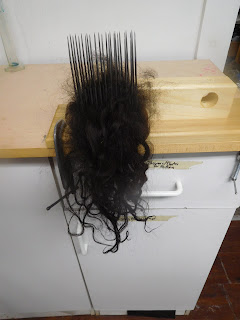Somehow I thought all Icelandic sheep had 2 horns or none. But it turns out that they can be polled (no horns or nonje in Icelandic!), have one, two, three or even four horns! And then there are sheep with different combinations of horn "buds" which appear....it's all very confusing genetics. Add the horn differences in with all the 28 colors and patterns, the "thoka" gene (attributed to some ewes that have many lambs), and the "leadersheep" oddity and you've got a very complex breed!
Polled and 4 horns are dominant, genetically speaking, but 2 horned sheep make up 70% of the flock in Iceland. I believe this has something to do with the focus on breeding for the more lucrative, "white" fleeces. Though horn number varies by region since some farmers prefer the ease of handling a polled sheep (no danger of injury if there are no horns!) and others prefer the regal look of a 2-4 horned sheep.
Since Icelanders try to use every part of an animal, the horns are used for buttons, tools, needles, etc. I purchased a few horn tip buttons at Alafoss - thought they might work into some future felt bags. Anna's workshop was full of sheep horns at various stages of use. She also had a reindeer rack (reindeer are not native to Iceland, but a few years back they brought some over from Norway - I don't know why). She intends to use them for buttons as well but said the smell when cutting a reindeer horn up is so bad she is waiting for the "right moment".
The color genetics of these sheep has always been a tad convoluted and nothing about the trip made it any clearer to me. Really....since when is white considered not a color but a pattern!? Anyway I wrote a little summary of the genetics of these sheep for a yarn CSA a couple of years ago if you're interested in reading it. I also have a great poster in the workshop here at the store which shows each of the 28 potential colors/patterns that these sheep come in, so check that out next time you're in if you want!
Another surprise was to learn was that the "leadersheep" (forystufe) are not necessarily dark brown with a badger face! For some reason, I thought that specific coloring was how you distinguished these unique leadersheep from the rest. I took this photo at the Hildarett roundup, sure that this was the leadersheep since he had the coloring I always associated with leadersheep! Now I realize he may be just as "ordinary" as the rest of the group!
In case you haven't heard about these leadersheep before, they are a unique subset of Icelandics ( less than .5% of Icelandics) that are exceptionally intelligent. Contrary to what I thought, it turns out that the leadersheep can be any color. And have any number of horns - or none!
Leadersheep are generally taller and trimmer than the other Icelandics. But what sets them apart most is their intelligence. They are somehow endowed with a tremendous sense of leadership, guardianship, and acute sense of direction and keen anticipation of weather changes. They herd other sheep much like border collies. So these unique abilities make these select sheep the ones that lead the flock out of danger and to safety. So I guess the only real way of identifying them is to observe them in the flock?
There are about 1500 of these "leadersheep" today, thanks to an effort in the 1970s to have leader rams at the AI insemination stations around Iceland. Obviously, this is not dominant if only ..5% of all the sheep turn out to have this distinct ability.
And then lastly, I have felted and spun Icelandic fleece before but have always chosen lamb fleeces (to get the softest) and then carded the tog and thel together, knowing that the tog was coarser but not as coarse as it could be since I had bought a lamb!
If you're just joining this discussion, these 2 aspects of the Icelandic fleece were discussed in an earlier post.
But having seen the handknit/handwoven articles in the Textile Museum in Blonduos that feature either the tog or the thel made me want to work with another Icelandic fleece just so I could go thru the process and experience such a fleece as 2 separate components, rather than one!
So I'm embarking on a project to separate tog from thel of some fiber I got there and am going to spin them separately and then knit something with each element spun separately. Why not add one more project to my ever increasing bucket list of "fiber-want-to-dos" !
So below I share a few photos of my start on this journey as I've separated the tog from the thel this week. The separation was easy by hand. A bit faster using a brush. But in both cases, I still ended up putting the tog thru my St. Blaise combs because I needed to produce a nice sliver for spinning. So in retrospect I should have just used the combs to begin with! They obviously did, since we saw Viking Combs in both the Textile Museum in Blonduos and also in the Turf Village we visited.
In this first photo, I laid a lock as shorn off the sheep next to the "tog" (long coarser 12" length) and the "thel" (shorter, softer clump) which I separated by hand.
This next photo shows some of the tog laid on my St. Blaise and then the photo below it shows the tog combed (took about 5 seconds!).
Lastly, here is the lovely sliver I"m pulling thru a diz.










No comments:
Post a Comment